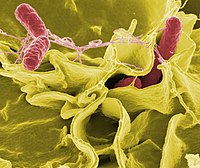
Photo from wikipedia
OBJECTIVES Proving causality between an exposure and outcome can be difficult in humans. Here, we utilize the Bradford Hills criteria to summarize the causal relationship between Campylobacter infection and the… Click to show full abstract
OBJECTIVES Proving causality between an exposure and outcome can be difficult in humans. Here, we utilize the Bradford Hills criteria to summarize the causal relationship between Campylobacter infection and the development of Irritable Bowel Syndrome (IBS). METHODS We utilized the Bradford Hills Criteria to assess the strength, consistency, specificity, temporality, biological gradient, plausibility, coherence, experiment, and analogy of the current evidence linking Campylobacter to IBS. Through a consensus amongst all authors, the confidence of each criterion was graded as high, moderate, low, or very low. RESULTS Four criteria (strength, temporality, plausibility, and analogy) were graded as high; four criteria (consistency. biological gradient, coherence, and experiment) were graded as moderate; and 1 criterion (specificity) was graded as low. Large-scale epidemiological studies report a risk ratio of 2.7-5.6 for developing IBS after campylobacter. In rodent models, C. jejuni 81-176 can cause loose stool months after the infection is cleared and share common pathophysiology as IBS patients such as elevated intestinal TLR-4 and IL-8, antibodies to CdtB and vinculin, increased intraepithelial lymphocytes and small intestinal bacterial overgrowth. CONCLUSIONS Campylobacter infection appear to cause IBS in a subset of patients. This may hold implication in risk factor identification, public health policy, and possibly treatment.
Journal Title: Pathogens and disease
Year Published: 2022
Link to full text (if available)
Share on Social Media: Sign Up to like & get
recommendations!